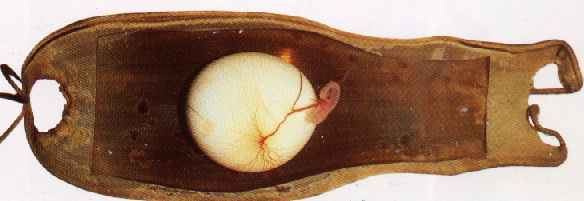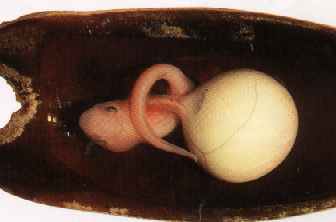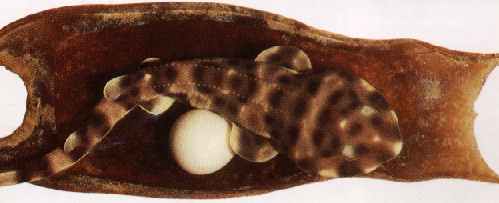
Main Page Content Page Next Page
| Finding a mate, for some sharks, means a long swim because males and females live in different parts of the ocean. When they meet, the male chases the female, biting her to encourage her to mate. He insert s one of his claspers into her cloaca, or body opening. Sea water already drawn into a sac in the male’s body is then squirted into a groove in his clasper to flush sperm into her cloaca. In this way, the sperm fertilizes the female’s eggs inside her body, unlike bony fish, where fertilization occurs outside the body with sperm and eggs being shed into the water. Fertilization may not happen immediately because some female sharks can store sperm until they are ready to reproduce. In most sharks, fertilized eggs develop in the female’s uterus, or egg tubes, and she gives birth to baby sharks, called pups. In other sharks, the fertilized eggs are encase in a leathery shell and deposited by the female on the sea bed. Once the eggs are laid, the female swims away, leaving them to develop and hatch on their own. These sharks are oviparous, which means their young hatch from an egg laid outside the mother - just like birds or bony fish. |
 |
| One-month-old swell shark embryo Swell sharks live on the eastern side of the Pacific Ocean in shallow waters. They are called swell sharks because when threatened they wedge themselves into rocky crevice by gulping in mouthfuls of water. If taken out of the water, a swell shark can still swell up by taking in air. The female lays two eggs at a time, depositing them among clumps of seaweed. Each egg is protected by a leathery case. One month after it was laid, the fertilized egg has developed into a tiny embryo. A large egg sac is full of yolk which nourishes the growing embryo. |
 |
Embryo at three months of age The embryo has grown much larger and it already has eyes and a tail. The yolk sac is connected to the embryo’s belly by a cord, while oxygen in the surrounding sea water passes through the leathery egg case so that the embryo is able to breathe. |
 |
Seven-month-old embryo By now the embryo looks much more like a baby shark. It has a complete set of fins and is able to wriggle about inside the egg case. The two rows of spines on the baby’s back will help give it a grip on the egg case as it pushes its way out. The baby sharks, or pup, will hatch as soon as it has used up the rest of the yolk sac. |